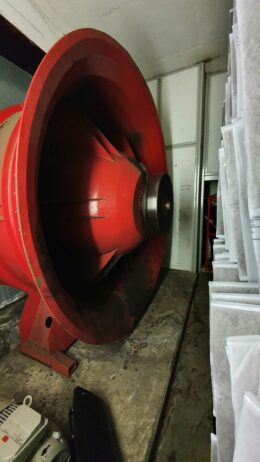When the maintenance staff for the air conditioning at the site dropped by at the old supply fan as part of their routine checks, they were astonished: the massive fan, with a diameter of over two meters, was damaged beyond repair. This was caused by vibrations that broke the conveyor blades, so the approximately thirty-year-old fan had finally been killed off.
This was not discovered immediately. “The system ventilates a relatively small manufacturing area as well as halls currently used as a warehouse. During routine checks, we asked ourselves why it was so quiet, then we saw it: blade breakage, total damage that caused it to disassemble itself,” explains Jens Goßmann, responsible for process optimization at Cordenka.
Strict requirements, high-quality replacements

At some point, everyone gives up: since the 30-year-old fan could no longer withstand the vibrations of the drive, which was not operating smoothly, even the blade broke. (Photos: HDS, Cordenka))
The company, which is headquartered in Obernburg am Main, has been producing technical viscous fibers since the factory was founded in 1924 and is now the leading manufacturer of technical rayon thread, which is predominantly used for car tires. For this reason, it is a matter of course that all machines, which are operated by around 600 employees, are of an outstanding quality. A high-quality, long-term reliable replacement was therefore required for the defective fan. Since Cordenka had already worked with ebm-papst, Goßmann approached the company directly and was referred to HDS GmbH, who took care of the planning process as a service partner of ebm-papst. Everyone started working together.
A hundred-year-old factory building, a large axial fan, a small service door: “The fan could not be replaced like-for-like without laborious building measures. We had to disassemble it into individual parts to get it out in the first place.” That is why Goßmann and HDS also planned for the tiny door when organizing the replacement – and decided on a fan wall. “With a modular design, you can create the same performance and also have greater flexibility: many old fans are located in small cellars, in which they are often fixed into a wall,” explains Jens Gerner, who led the project at HDS together with his colleague Jens Martin.
Up until then, the old axial compact fan could only be switched ‘on’ or ‘off’. So that energy does not literally vanish into thin air, we had already closed ventilation ducts that were not required in the warehouse in some cases. Jens Goßmann
100,000 cubic meters of air flow per hour: this maximum power had to be reproduced using the RadiPac series’ EC centrifugal fans. “A 08/15 fan cannot achieve that.”
From axial to centrifugal

HDS planned the FanGrid with eight RadiPacs and supplied them in a modular system as individual modules and pre-assembled.
Therefore, HDS planned the FanGrid with eight RadiPacs and supplied them in a modular system as individual modules and pre-assembled. From this point on, Cordenka’s service providers took care of assembly and connection. “The HDS plans were very good and the installation went smoothly,” says Goßmann. The new modules have been in operation for four months and run smoothly. And that is not all: they are infinitely adjustable.
“Up until then, the old axial compact fan could only be switched ‘on’ or ‘off’. So that energy does not literally vanish into thin air, we had already closed ventilation ducts that were not required in the warehouse in some cases.” Cordenka can now also regulate the air flow into the supplied manufacturing facility because of the fans’ control characteristics, which actively saves energy. If production begins again in the warehouse at a later time, the ventilation ducts will be opened again and the fans will be adjusted appropriately. And if, contrary to expectations, a fan has a problem in the future, seven more fans will effortlessly pick up the slack it is repaired. At present, Cordenka is already testing how air quality can be improved using the fan wall.
For the successful project, Cordenka was awarded BAFA Module 1 support for using efficient cross-section technologies. In the future, further retrofits with EC centrifugal fans could also be planned. “These have the advantage that they can be easily accommodated in relatively small rooms and can be integrated into intelligent control systems. This enables us to use them according to requirements and in a way that is more energy-efficient.”



Leave a comment